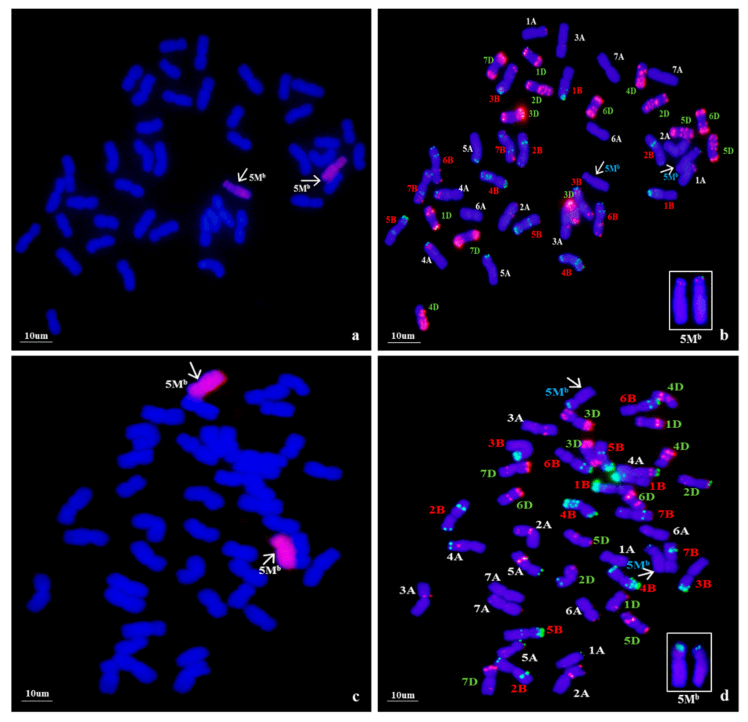Aline Chromosomes Identification
Creative Bioarray offers custom, pre-commercialized probe products to assist customers in hybridization that can be used to analyze foreign chromosomes in the progeny of hybrids. Plant breeding efforts require an expanded pool of agronomic traits. At present, there is a lack of complete commercial plant chromosome probe sets, and most studies usually adopt a customized approach. Our probe customization service assists breeding efforts in designing and customizing probe sets suitable for research.
Monosomic Alien Chromosome Addition and Substitution
The introgression of the alien chromosomes has become a valuable tool for expanding the genetic variability of crop plants through chromosome engineering. Monosomic alien addition and substitution lines (MAAL and MASL) are widely used as bridges for transferring desired genes from wild species to superior varieties. When producing interspecific hybrids, backcrossing is required to generate addition, substitution, and translocation lines. Simply put, it is the transfer of the required genes from one species to another through interspecific hybridization and backcrossing, which may produce monomeric and disomy additions as intermediate hybrid products. The generation of alien disomic addition lines and alien chromosome substitution lines is of great significance for genetic research and chromosome engineering.
Their specific genetic and cytogenetic characteristics make them a powerful tool for basic research to clarify the regulation of homologous recombination, the distribution of chromosome-specific markers and repetitive DNA sequences, and the regulation of heterologous gene expression. This aneuploidy contains foreign chromosomes added to the complement of the recipient parent and can be used for further gene introgression procedures. Monosomic and disomic alien addition may have specific morphological characteristics, but additional molecular marker identification and FISH/GISH analysis are also required.
 Fig 1. Genomic in situ hybridization (GISH) and non-denaturing fluorescence in situ hybridization (ND-FISH) detection of mitotic chromosomes in the root tips. (Song L, et al. 2020)
Fig 1. Genomic in situ hybridization (GISH) and non-denaturing fluorescence in situ hybridization (ND-FISH) detection of mitotic chromosomes in the root tips. (Song L, et al. 2020)
Custom Probes Help Agricultural Breeding
Alien chromosome addition lines have been widely used to identify gene linkage groups, the comparison of gene homology between related species, and the chromosomal matching of species-specific characteristics. This is a scientific research service for researchers who are engaged in research projects of interspecific hybridization and improvement of agronomic traits. In the field of plant hybrid breeding, the application of MAAL and MASL lies in the characteristics of increased agronomic value. Wild relatives and related species with homoeologous genomes are important for broadening the genetic variability of crop plants. For many crops, wild relatives provide a vast reservoir for most of the agronomically important traits. We are committed to expanding our FISH assays to help crop breeding in the agricultural field, and our probe customization service is currently a good choice to help customers shorten research cycles and obtain more beautiful analysis maps.
 Fig 2. FISH analysis of alien chromosomes of hybrid offspring.
Fig 2. FISH analysis of alien chromosomes of hybrid offspring.
Creative Bioarray offers customization of a variety of FISH solutions and the design of probe products. Our services help researchers in the field of plant research with probe design and customization. The analysis of foreign chromosomes in plant hybrids can be achieved by FISH/GISH technology, including analysis of chromosomal mutations such as foreign infiltrating chromosomal rearrangements and translocations. If you are interested in our services, please contact us for cooperation. We look forward to cooperating with you in the near future.
References
- Song L, Zhao H, Zhang Z, et al. Molecular cytogenetic identification of wheat-aegilops biuncialis 5Mb disomic addition line with tenacious and black glumes[J]. International journal of molecular sciences, 2020, 21(11): 4053.
- Chang S B, de Jong H. Production of alien chromosome additions and their utility in plant genetics[J]. Cytogenetic and Genome Research, 2005, 109(1-3): 335-343.
All products and services on this website are only suitable for non-medical purposes.


 Fig 1. Genomic in situ hybridization (GISH) and non-denaturing fluorescence in situ hybridization (ND-FISH) detection of mitotic chromosomes in the root tips. (Song L, et al. 2020)
Fig 1. Genomic in situ hybridization (GISH) and non-denaturing fluorescence in situ hybridization (ND-FISH) detection of mitotic chromosomes in the root tips. (Song L, et al. 2020) Fig 2. FISH analysis of alien chromosomes of hybrid offspring.
Fig 2. FISH analysis of alien chromosomes of hybrid offspring.


